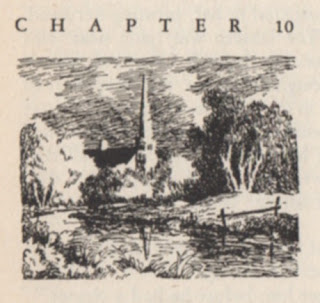At the end of
my review of Margaret Millar's Rose's Last Summer, I put it that the title character, Rose French, had seen her Hollywood career done in by age. It's wrong to blame her downfall on drink, though I do understand the presumption. "Rose was on the skids again," begins the novel. "Everyone in the boarding house knew it."
The 1960 Thriller adaptation opens with a drunken Rose being thrown out of a bar.
But to suggest that Rose's career was ruined by alcohol is to ignore the fact that she always drank, and likely drank even more when her star was high. I'll add that her social worker, psychologist Frank Clyde, doesn't consider Rose an alcoholic. Who am I to disagree? Frank is the most sober, level-headed character in the novel, and I'm no social worker. I'm no psychologist either, though I do see something in this early passage:
She changed into her best silk print, combed her short hair carefully, and put on some makeup. Surveying the results of this effort in the mirror, she decided that she looked pretty good considering that she had fifty-two years of assorted living behind her.
Fifty-two. She decided that she looked pretty good considering. In fact, Rose French is sixty-five years old.
Rose's self-examination comes after finding "reassurance" on the walls of her boarding house room:
They were covered, from floor to ceiling, with photographs of herself, smiling, sultry, coy, gay; in period costumes and bathing suits; stills and action shots; Rose being kissed, strangled, rescued, fed to the lions, lighting a cigarette, toasting a lover, dancing a polka.
In the television adaptation, the camera gives a glimpse of one of those walls, as
Thriller host Boris Karloff narrates:
Rose French. In the blur of memory the face grows dim, but do you remember the name? Twenty years ago... Rose French, the remarkable Rose French, as a servant girl or as a princess she was a quicksilver star in a celluloid heaven.
Cut to an old issue
True Confessions, atop a pile of magazines.
Fans of old films – I'm one – will recognized that all those stills feature Mary Astor. That old issue of
True Confessions (April 1932), has the actress on its cover. Mary Astor plays Rose French in
Rose's Last Summer, and makes her co-stars look weak. Lin McCarthy, who plays Frank Clyde, comes off like a slow-moving automaton.
Reviewing
Rose's Last Summer I cut off discussion of the plot so as to avoid spoilers. I'll be going a bit further here.
The forty-nine minute
Thriller episode is nowhere near as nuanced as Miller's 245-page novel (Random House first edition), but the basic story is the same: Rose French is an unstable faded film star who lives in a boarding house north of Hollywood. Frank Clyde is a social worker who goes above and beyond in trying to help. Unexpectedly, and improbably, Rose announces that she's taken a job somewhere. The following day, her death makes the front pages.
Bette Davis turned down Millar's
The Iron Gates because her character, Lucille Morrow, would've died just past the half-way mark. Reports of Rose's death come nine minutes into this drama... but she isn't really dead. Karloff does his best to deceive by introducing "our principal players" as "Miss Mary Astor, Mr Lin McCarthy, and Miss Helen Quintal."
"Miss Helen Quintal" is actually Mary Astor. Rose has been hired by to pass herself off as the matriarch of the wealthy Goodfield family in the event that Mrs Goodfield dies before her childrens' inheritances are secure. In the novel, avoiding estate tax is the issue. In the
Thriller adaptation, the crisis is caused by a will left by eccentric patriarch Horace G. Goodfield.
Mrs Goodfield dies too early. The novel sees son Willett and daughter-in-law Ethel look to transport her body far from the house. It proves too stiff and unwieldily, so they end up dumping it, face down, beside their lily pond. Rose's purse is placed beneath the dead woman. In the
Thriller adaptation, the dead body is found slumped over on a stone bench in the Goodfield's garden.
And so, Astor plays a former film star who takes on the role of a dead woman because Hollywood has nothing for her.
Rose's Last Summer isn't the best television, and doesn't seem much when compared to films like
Convention City (1933),
The Prisoner of Zenda (1937),
The Great Lie (1941) and
The Maltese Falcon (1941), but I can't help but think that Astor saw Rose French as something more than just another role. Astor herself wrote that she began abusing alcohol in the 'thirties. In 1951, following a suicide attempt, she joined Alcoholics Anonymous, converted to Roman Catholicism, and by all accounts turned her life around. And yet, despite her newfound stability, her career declined with age. She became frustrated by the bland roles – more often than not mothers – offered her.
Where Rose turned to the Goodfields, Astor turned to television. From 1954 through 1963, she took on in forty-seven roles for the small screen, but appeared in only seven movies. Her last performance was as Jewel Mayhew in
Hush... Hush, Sweet Charlotte (1964), a role she described as "a little old lady, waiting to die."
Mary Astor was fifty-eight when she shot those scenes. She was fifty-four when she did
Rose's Last Summer... in which she played a woman of sixty-five.
The hell that is Hollywood.
I wonder who supplied
Thriller with all that Mary Astor memorabilia.
Related posts:
















































